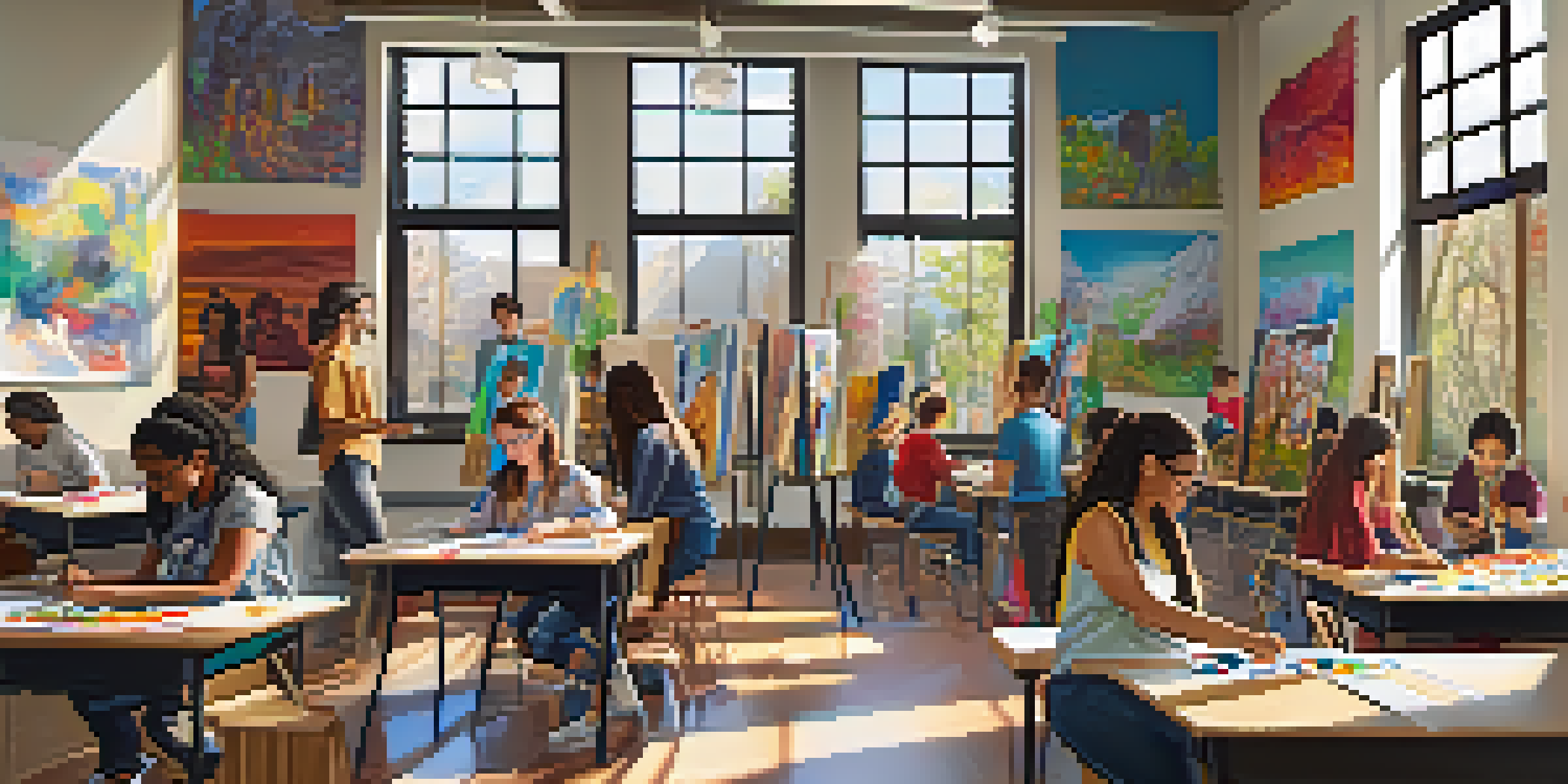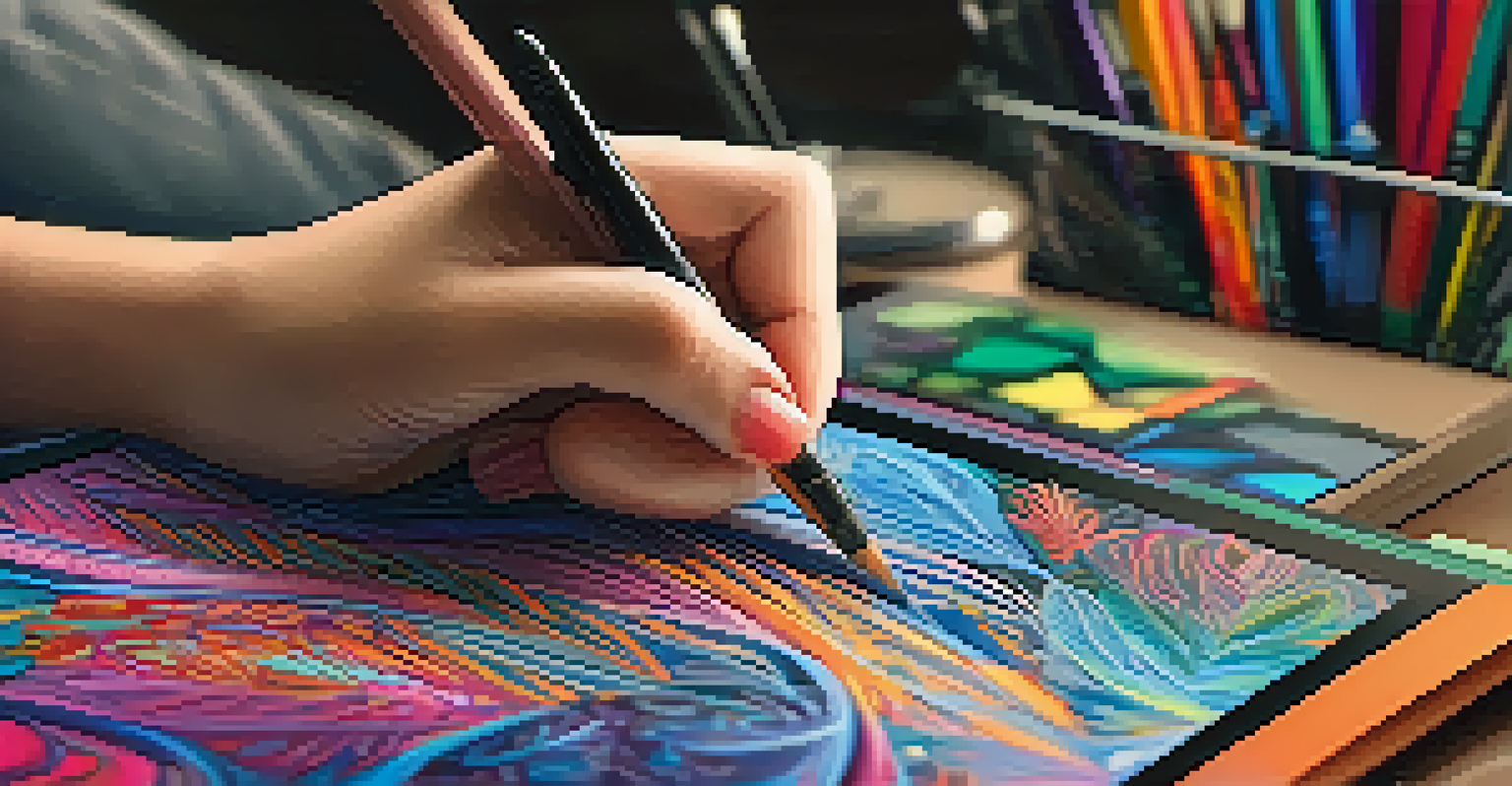Art Education Programs: Challenges and Opportunities

Understanding the Importance of Art Education
Art education is vital as it nurtures creativity and critical thinking. It allows students to express themselves in unique ways, developing skills that are transferable across various disciplines. Beyond just creating art, it fosters an appreciation for culture and history, enriching students' understanding of the world around them.
Art enables us to find ourselves and lose ourselves at the same time.
Moreover, art education plays a crucial role in personal development. It encourages self-discipline, patience, and resilience, all of which are essential qualities in today’s fast-paced society. By engaging with art, students learn to navigate their emotions and build confidence in their creative abilities.
In a broader context, art education contributes to community building. It brings people together, creates dialogue, and promotes inclusivity, making it an essential component of a well-rounded education. As society evolves, the need for creative thinkers becomes increasingly important.
Identifying Challenges Facing Art Education Programs
Despite its importance, art education faces several challenges, primarily funding cuts in schools. Many institutions prioritize subjects like math and science, often sidelining the arts, which can lead to diminished programs and resources. This trend can discourage students from pursuing their artistic interests.

Additionally, there is often a lack of trained art educators who can effectively inspire and guide students. Many teachers may have limited exposure to contemporary art practices or technologies, which can hinder their ability to provide a comprehensive education. This gap can leave students feeling unsupported in their artistic endeavors.
Art Education Fosters Creativity
Art education nurtures creativity and critical thinking, allowing students to express themselves and develop transferable skills.
Finally, the undervaluation of art in society contributes to these challenges. The perception that art is a luxury rather than a necessity can lead to reduced enrollment in art programs, making it harder for schools to justify their existence. This cycle reinforces the barriers that art education must overcome.
Exploring Funding Opportunities for Art Programs
To combat funding challenges, many art programs are seeking alternative sources of support. Grants from local, state, and national arts organizations can provide essential funding for materials, workshops, and exhibits. Schools are increasingly encouraged to apply for these grants to enhance their art offerings.
Every artist was first an amateur.
Additionally, community partnerships can play a significant role. Collaborating with local artists, galleries, and businesses can bring fresh resources and expertise into art programs, enriching the educational experience for students. These partnerships often lead to community events that showcase student work and foster greater appreciation for the arts.
Moreover, crowdfunding has emerged as a viable option for funding art projects. By leveraging social media and online platforms, schools can rally support from parents and community members. This approach not only raises money but also builds a strong sense of community around art education.
The Role of Technology in Art Education
Technology has transformed art education, making it more accessible and engaging for students. Digital tools allow for a vast array of creative expression, from graphic design to digital painting. These resources can inspire students who may not feel comfortable with traditional mediums.
Moreover, online platforms provide opportunities for collaboration and sharing. Students can connect with peers around the world, gaining diverse perspectives and feedback on their work. This global reach can enhance their artistic development, pushing them to explore new ideas and techniques.
Funding Challenges Persist
Many art programs face significant funding cuts and a lack of trained educators, impacting their ability to inspire students.
Finally, technology enables educators to incorporate innovative teaching methods. Virtual reality, for instance, can immerse students in art history or allow them to experience art in ways not previously possible. This integration of technology keeps art education relevant and exciting in an ever-evolving digital landscape.
Promoting Inclusivity in Art Education
Inclusivity in art education ensures that all students feel represented and valued. By incorporating diverse artists and cultural perspectives into the curriculum, educators can create a more engaging and relevant learning environment. This approach encourages students to explore their identities through their art.
Additionally, providing resources and support for students with disabilities is crucial. Adaptive tools and techniques can help ensure that every student has the opportunity to participate in art classes. When all students can express themselves creatively, it fosters a sense of belonging.
Creating an inclusive atmosphere also promotes collaboration among students from different backgrounds. Through group projects and discussions, students can share their unique experiences and learn from one another. This enriched learning experience benefits not only the individual but the entire classroom community.
The Impact of Art Education on Career Opportunities
Art education doesn’t just cultivate creative skills; it also opens up numerous career paths for students. Fields such as graphic design, architecture, and multimedia arts all stem from a strong foundation in artistic principles. This versatility equips students with valuable skills they can apply in various industries.
Moreover, the critical thinking and problem-solving abilities developed through art education are highly sought after in today’s job market. Employers often look for candidates who can think outside the box, communicate effectively, and adapt to changing environments. Art students are uniquely positioned to meet these demands.
Inclusivity Enhances Learning
Promoting inclusivity in art education creates a more engaging environment where all students feel represented and valued.
Finally, art education fosters entrepreneurial spirit among students. Many artists go on to start their own businesses or freelance careers, allowing them to carve their own paths. By empowering students with the knowledge and skills needed to succeed, art education plays a vital role in shaping their futures.
Looking Ahead: The Future of Art Education Programs
The future of art education programs is bright, thanks to emerging trends and innovative approaches. As more educators recognize the importance of creativity, we can expect to see a resurgence of art programs in schools across the country. This shift will hopefully lead to a more balanced educational experience for students.
Additionally, the integration of interdisciplinary methods will likely become more common. By combining art with subjects like science, technology, and literature, students can gain a deeper understanding of how creativity intersects with various fields. This approach prepares them for the complexity of the modern world.

Ultimately, the ongoing advocacy for art education will play a significant role in its future. As communities rally around the importance of creativity in education, we can anticipate positive changes that will benefit both students and society as a whole. Together, we can ensure that art education continues to thrive for generations to come.